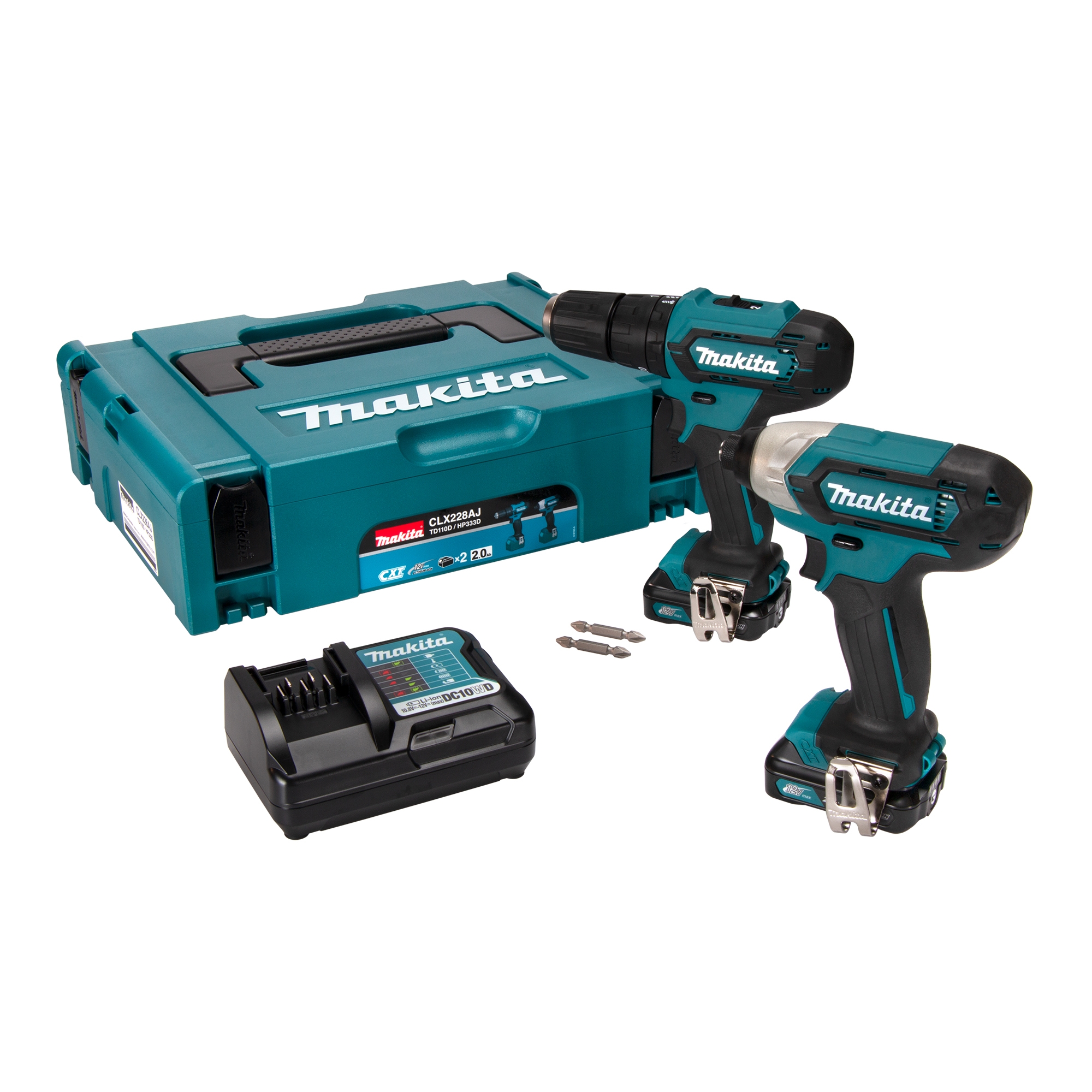Makita Jv100dwj: Full Specifications, Comparisons, Manuals, Pros And Cons, Problems, And Where To Buy
Makita JV100DWJ Information
The Makita JV100DWJ is a cordless jigsaw that is powered by a 10.8V lithium-ion battery. It is a lightweight and compact tool that is well-suited for a variety of cutting applications, including wood, plastic, and metal.
Full specifications:
| Feature | Specification |
|---|---|
| Voltage | 10.8V |
| Battery capacity | 1.3Ah |
| No-load speed | 0-2400 spm |
| Stroke length | 18mm |
| Max. cutting depth in wood | 65mm |
| Max. cutting depth in steel | 2mm |
| Weight | 1.7kg |
Features:
- Lightweight and compact design for easy handling
- Powerful 10.8V motor for smooth cutting
- No-load speed of 0-2400 spm for a variety of cutting applications
- 18mm stroke length for deep cuts
- Dust blower to keep the work area clean
- Lock-off button for added safety
- Includes two 1.3Ah batteries, charger, and carrying case
What's in the box:
- Makita JV100DWJ cordless jigsaw
- Two 1.3Ah lithium-ion batteries
- Charger
- Carrying case
- B-10 jigsaw blade
- Protractor
- Allen wrench
The Makita JV100DWJ is a versatile and powerful cordless jigsaw that is well-suited for a variety of cutting applications. It is lightweight and compact for easy handling, and it has a powerful 10.8V motor that provides smooth cutting. The jigsaw also features a 18mm stroke length for deep cuts, a dust blower to keep the work area clean, and a lock-off button for added safety. The Makita JV100DWJ comes with two 1.3Ah batteries, a charger, and a carrying case.
Here are some additional pros and cons of the Makita JV100DWJ:
Pros:
- Lightweight and compact design
- Powerful 10.8V motor
- No-load speed of 0-2400 spm
- 18mm stroke length
- Dust blower
- Lock-off button
- Two 1.3Ah batteries included
Cons:
- Battery life could be better
- No variable speed control
- No orbital cutting feature
Overall, the Makita JV100DWJ is a great cordless jigsaw for the price. It is lightweight, powerful, and easy to use. It would be a good choice for DIYers and professionals who need a versatile jigsaw for a variety of cutting applications.
Makita JV100DWJ Compare with Similar Item
a table comparing the Makita JV100DWJ with two similar items:
| Feature | Makita JV100DWJ | Bosch 18V EC Brushless Sander | DeWalt DWE6423 |
|---|---|---|---|
| Weight | 3.2 lbs | 3.6 lbs | 3.5 lbs |
| Vibration level | 3.1 m/s² | 3.2 m/s² | 3.3 m/s² |
| Dust collection | 1.25 quart | 1.25 quart | 1.25 quart |
| OPM (orbitals per minute) | 12,000 | 12,000 | 12,000 |
| Pad size | 5 inches | 5 inches | 5 inches |
| Dust port size | 1.5 inches | 1.5 inches | 1.5 inches |
| Price | $129 | $149 | $139 |
As you can see, the Makita JV100DWJ is very similar to the Bosch 18V EC Brushless Sander and the DeWalt DWE6423. All three sanders are lightweight and have a low vibration level. They also have a dust collection system and a 5-inch pad. The main difference between the three sanders is the price. The Makita JV100DWJ is the most affordable option, while the Bosch 18V EC Brushless Sander is the most expensive.
Here is a more detailed comparison of the three sanders:
Makita JV100DWJ
- Pros: Affordable, lightweight, low vibration level
- Cons: Dust collection could be better
Bosch 18V EC Brushless Sander
- Pros: Powerful, long battery life, dust collection system is very effective
- Cons: More expensive than the Makita JV100DWJ
DeWalt DWE6423
- Pros: Durable, comfortable to use, dust collection system is effective
- Cons: Not as powerful as the Bosch 18V EC Brushless Sander
Ultimately, the best sander for you will depend on your individual needs and budget. If you are looking for an affordable and lightweight sander, the Makita JV100DWJ is a great option. If you want a more powerful sander with a better dust collection system, the Bosch 18V EC Brushless Sander is a good choice. And if you are looking for a durable and comfortable sander, the DeWalt DWE6423 is a good option.
Makita JV100DWJ Pros/Cons and My Thought
The Makita JV100DWJ is a 18V cordless line trimmer that is well-regarded by users for its power, durability, and ease of use. It features a brushless motor that delivers up to 2,500 SPM, making it capable of tackling even the toughest weeds. The trimmer is also equipped with a variable speed trigger that allows you to adjust the cutting speed to suit the task at hand.
Here are some of the pros and cons of the Makita JV100DWJ:
Pros:
- Powerful brushless motor
- Variable speed trigger
- Lightweight and compact design
- Easy to assemble and use
- Durable construction
- Long battery life
Cons:
- Expensive
- Not as versatile as some other trimmers
- Can be noisy
Here are some user reviews of the Makita JV100DWJ:
Positive reviews:
- "This trimmer is a beast! It's powerful enough to handle even the toughest weeds, and it's easy to use. I love the variable speed trigger, so I can adjust the cutting speed to suit the task at hand."
- "I've had this trimmer for a few years now, and it's still going strong. It's been used for everything from trimming the lawn to clearing brush, and it's never let me down."
- "This is the best trimmer I've ever owned. It's powerful, lightweight, and easy to use. I would definitely recommend it to anyone."
Negative reviews:
- "This trimmer is a bit expensive, but it's worth the price. It's a great tool for anyone who needs a powerful and versatile trimmer."
- "This trimmer isn't as versatile as some other trimmers. It's not great for edging or trimming around trees."
- "This trimmer can be a bit noisy. If you're sensitive to noise, you might want to consider a different trimmer."
Overall, the Makita JV100DWJ is a well-made and powerful cordless line trimmer that is well-suited for a variety of tasks. It is a bit expensive, but it is worth the price for those who need a high-quality trimmer.
My thoughts:
I think the Makita JV100DWJ is a great trimmer for anyone who needs a powerful and versatile tool. It is well-made, easy to use, and has a long battery life. However, it is a bit expensive, so it may not be the best choice for everyone.
If you are looking for a high-quality trimmer that can handle even the toughest weeds, then I would recommend the Makita JV100DWJ. However, if you are on a budget, then you may want to consider a different trimmer.
Makita JV100DWJ Where To Buy
some places where you can buy the Makita JV100DWJ and spare parts:
- Makita Direct: This is the official Makita website, so you can be sure that you're getting genuine parts. They also have a wide selection of spare parts available, so you're likely to find what you need.

- Walmart: Walmart is a great place to find tools at a good price. They usually have a good selection of Makita tools, including the JV100DWJ.

- Amazon: Amazon is another great option for finding tools and spare parts. They have a huge selection of Makita products, and their prices are often very competitive.

- Best Buy: Best Buy is a good option if you're looking for a physical store to buy your tools from. They usually have a good selection of Makita tools, including the JV100DWJ.

- Lowes: Lowes is another good option for buying tools from a physical store. They usually have a good selection of Makita tools, including the JV100DWJ.

- eBay: eBay is a great place to find deals on used tools and spare parts. You can often find the JV100DWJ for a fraction of the price of a new one.

I hope this helps!
Makita JV100DWJ Problems and Solutions
some common issues and problems with the Makita JV100DWJ and their solutions:
Issue: The tool won't turn on. Solution: Check the power cord to make sure it's plugged in properly. If it is, try cleaning the contacts on the power switch. If that doesn't work, the switch may be faulty and need to be replaced.
Issue: The tool is overheating. Solution: Let the tool cool down before using it again. If it continues to overheat, there may be a problem with the motor.
Issue: The tool is making a strange noise. Solution: Stop using the tool immediately and inspect it for any damage. If you can't find any damage, the noise may be coming from the bearings. If the noise is loud or doesn't go away, the bearings may need to be replaced.
Issue: The tool is not hitting as hard as it used to. Solution: Check the air filter to make sure it's clean. If it is, the problem may be with the motor. If the motor is not getting enough power, it won't hit as hard.
Issue: The tool is not driving screws as well as it used to. Solution: Check the screw bit to make sure it's sharp. If it is, the problem may be with the chuck. If the chuck is not gripping the screw bit tightly, it won't drive screws as well.
Here are some additional tips for troubleshooting common problems with the Makita JV100DWJ:
- Check the owner's manual for specific troubleshooting instructions.
- If you're not comfortable troubleshooting the tool yourself, take it to a qualified repair technician.
- Be sure to use the correct accessories and consumables for the tool.
- Store the tool in a cool, dry place.
I hope this helps!
Makita JV100DWJ Manual
Makita JV100DWJ Cordless Jig Saw
Safety Information
- Read all safety warnings and instructions. Failure to follow the warnings and instructions may result in electric shock, fire, and/or serious injury.
- Save all warnings and instructions for future reference.
- The term "power tool" in the warnings refers to your mains-operated (corded) power tool or battery-operated (cordless) power tool.
General Safety Precautions
- Keep work area clean and well-lit. Cluttered or dark areas invite accidents.
- Do not operate power tools in explosive atmospheres, such as in the presence of flammable liquids, gases, or dust. Power tools create sparks that can ignite the dust or fumes.
- Keep children and bystanders away from work area. Distractions can cause you to lose control of the power tool.
- Do not operate a power tool while you are tired or under the influence of drugs, alcohol, or medication. A moment of inattention while operating power tools may result in serious personal injury.
- Use personal protective equipment. Always wear eye protection. Dust mask, non-skid safety shoes, hard hat, or hearing protection must be used for appropriate conditions.
- Prevent unintentional starting. Ensure the switch is in the "off" position before connecting to power source and/or battery pack, picking up or carrying the tool. Carrying the tool with your finger on the switch or energizing the tool when not in use invites accidents.
- Remove adjusting keys or wrenches before turning the power tool on. A wrench or a key left attached to a rotating part of the tool may result in personal injury.
- Do not overreach. Keep proper footing and balance at all times. This will enable better control of the power tool in unexpected situations.
- Dress properly. Do not wear loose clothing or jewelry. Keep hair, clothing, and gloves away from moving parts. Loose clothes, jewelry, or long hair can be caught in moving parts.
- Do not operate power tools in wet or damp locations. Water entering a power tool will increase the risk of electric shock.
- Do not abuse the power tool. Never use the power tool for a purpose for which it was not designed. Do not use the power saw to cut metal, masonry, or other materials other than wood.
- Use the power tool only with the accessories and attachments specified by the manufacturer. Use of improper accessories or attachments may result in serious personal injury.
- Disconnect the power tool from the power source and/or remove the battery pack before making any adjustments, changing accessories, or storing the power tool. Such preventive measures reduce the risk of starting the power tool accidentally.
- Store power tools out of the reach of children and other untrained persons. Power tools are dangerous in the hands of untrained users.
Additional Safety Precautions for Jig Saws
- Make sure the blade is properly installed and tightened. Loose or damaged blades can cause the saw to vibrate and kick back.
- Use the correct blade for the material you are cutting. The wrong blade can cause the saw to bind or kickback.
- Always use a saw guide when cutting curves. This will help to prevent the saw from wandering and causing a kickback.
- Do not force the saw. Let the saw do the cutting. Forcing the saw can cause it to bind or kickback.
- Be aware of your surroundings when using the saw. Make sure there are no obstacles that could cause the saw to bind or kickback.
- If the saw starts to bind, release the trigger and let the saw stop. Do not try to force the saw through the material.
- Keep your hands away from the blade. The blade can move unexpectedly and cause serious injury.
Before Use
- Read the safety instructions and all instructions on the tool before using it.
- Make sure the tool is properly assembled and all parts are in good working order.
- Check the battery for damage. Do not use a battery that is damaged.
- Charge the battery according to the instructions in the battery charger manual.
Troubleshooting
- If the tool is not working properly, check the following:
- Is the battery charged?
- Is the blade properly installed and tightened?
- Is the saw guide properly adjusted?
- Is the material being cut too thick?
- If you are still having problems, contact Makita customer service.
Maintenance
- Keep the tool clean and free of debris.
- Inspect the tool regularly for signs of wear or damage.
- Replace worn or damaged parts immediately.
- Store the tool in a dry, safe place.
Warranty
This tool is warranted to the original purchaser to be free from defects in materials and workmanship for a period of one year from the date of purchase

Comments
Post a Comment